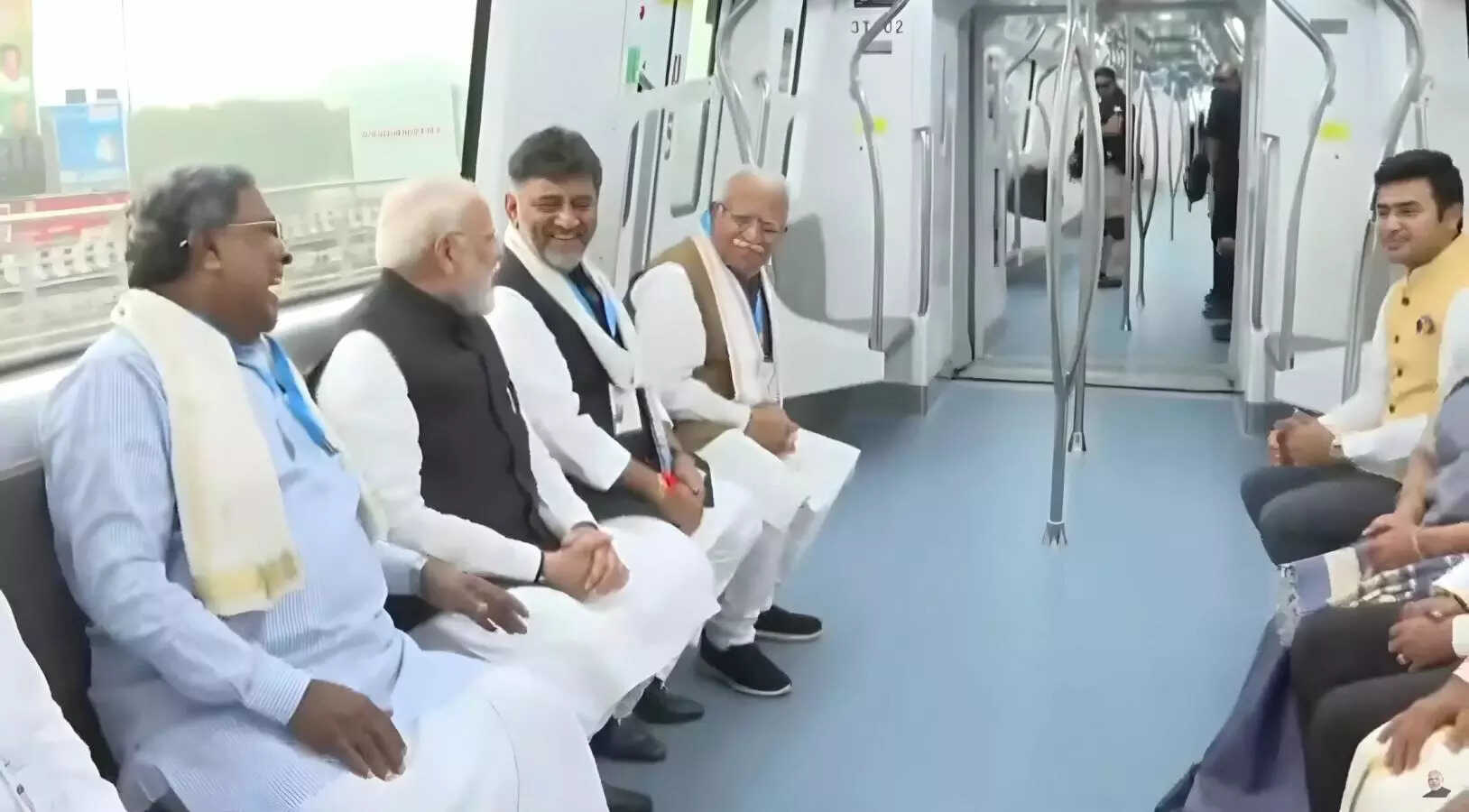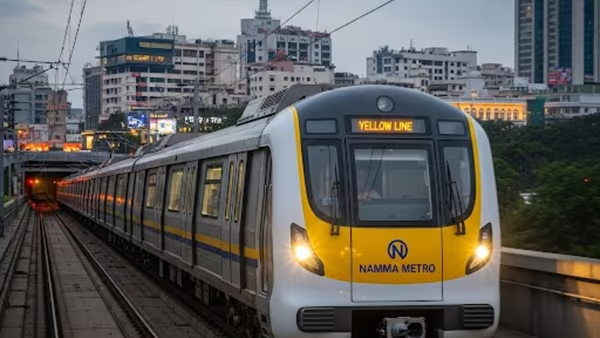Bengaluru, August 10, 2025 The wait is finally over for thousands of daily commuters in Bengaluru. Prime Minister Narendra Modi officially inaugurated the much-anticipated Yellow Line of Namma Metro today, marking a major milestone in the city’s transport network.
The event was more than just a ribbon-cutting ceremony. PM Modi himself took a ride on the brand-new metro line, traveling from Ragigudda (RV Road) to Infosys Foundation–Konappana Agrahara station. Karnataka Chief Minister Siddaramaiah and Deputy CM D.K. Shivakumar joined him for the ride, sharing the excitement of a project that has been in the making for nearly a decade.
Project Timeline and Builders
The Yellow Line project was first proposed in 2015 and construction began in 2017. It is part of Namma Metro’s Phase 2, implemented by the Bangalore Metro Rail Corporation Limited (BMRCL).
Civil construction contracts for different sections were awarded to multiple companies, including HCC–URC JV, ITD Cementation India, and Tata Projects Ltd. The rolling stock (trainsets) were supplied by CRRC Nanjing Puzhen Co., Ltd., with driverless technology integrated into the system.
Delays due to land acquisition challenges, shifting utility lines, and the COVID-19 pandemic pushed completion from the original target of 2022 to 2025.
A Long-Awaited Project
The Yellow Line, which connects RV Road in South Bengaluru to Bommasandra in the city’s southern industrial corridor, covers 19 kilometers and has 16 stations.
This metro stretch has been under construction for about eight years and cost ₹7,610 crore. For residents of Electronics City, one of India’s biggest IT hubs, this metro line is a game-changer. It promises to slash travel time, reduce road traffic, and offer a safer, more eco-friendly way to commute.
Why the Yellow Line Matters for Bengaluru
Bengaluru is often called India’s “Silicon Valley,” but the city has also become infamous for its traffic jams. According to transport experts, the Yellow Line will:
- Connect key residential, commercial, and industrial hubs
- Provide direct metro access to Electronics City
- Offer seamless transfers to other metro lines in the future
- Encourage more people to use public transport, reducing congestion and pollution
The new line is also fitted with driverless trainsets, adding a modern, high-tech touch to the city’s transport system. Initially, trains will run every 25 minutes, but frequency is expected to increase as more trains are deployed.
First Ride with the PM
Crowds gathered at stations along the Yellow Line to catch a glimpse of the Prime Minister. Inside the train, PM Modi interacted with metro officials, inspected the interiors, and discussed the project’s significance for Bengaluru’s growth.
“This is more than just a metro line. It’s a lifeline for the people of Bengaluru,” PM Modi said during his address at the inauguration. “The Yellow Line will not only make travel faster but will also improve the city’s quality of life.”
Major IT and Business Hubs Covered
The Yellow Line strategically connects several major tech parks and company campuses:
- Infosys and Wipro campuses in Electronics City
- Tech Mahindra, HCL, TCS, Siemens, and HP offices along Bommasandra–Electronic City stretch
- Biocon headquarters in Hebbagodi
- Multiple industrial units in Bommasandra Industrial Estate
- Upcoming Metro-NICE Road interchange for better access to Bengaluru’s outskirts
This route is expected to serve lakhs of IT employees who currently spend hours in traffic.
Does the Yellow Line Connect to the Airport?
The Yellow Line does not directly connect to Kempegowda International Airport. However, passengers can change to the Blue Line or Pink Line in the future to access the airport once those lines are completed under Phase 2B and Phase 3.
Currently, airport connectivity is available via the Airport Express (Blue Line) under construction.
A Boost for Commuters and Businesses
For professionals working in Electronics City and nearby areas, the Yellow Line means fewer hours spent in traffic and more time at work or with family. Industrial zones along the route will also benefit, as workers can reach offices and factories faster and with less stress.
Shalini Rao, a software engineer from Bommasandra, expressed her excitement:
“I used to spend almost two hours every morning just to get to work. With this metro, I can cut that time by more than half. It’s going to change my daily life.”
Local businesses are equally optimistic. Shop owners near metro stations expect increased foot traffic, while real estate developers foresee higher demand for homes close to the new route.
Yellow Line Route and Key Stations
The 16 stations on the Yellow Line include:
- RV Road (Ragigudda)
- Mico Industries
- Dairy Circle
- Hulimavu
- Gottigere
- Hongasandra
- HSR Layout
- Central Silk Board
- BTM Layout
- Kudlu Gate
- Singasandra
- Electronic City I
- Electronic City II
- Infosys Foundation–Konappana Agrahara
- Hebbagodi
- Bommasandra
This route connects educational institutions, tech parks, residential complexes, and industrial estates making it one of the most strategically important metro lines in the city.
When Will It Open for Public?
Passenger services on the Yellow Line will begin 11th Aug Monday at 5 a.m. The Bangalore Metro Rail Corporation Limited (BMRCL) expects a strong response from commuters on day one.
Special offers are likely during the first week to encourage more people to try the new metro line. Authorities are also planning awareness drives on safety, ticketing, and last-mile connectivity options like feeder buses and bike-sharing services.
Future Plans: Metro Phase-3 and Beyond
Today’s inauguration wasn’t just about the Yellow Line. PM Modi also laid the foundation stone for Namma Metro Phase-3, which will add new routes and extensions to the network.
In addition, three new Vande Bharat Express trains were launched to improve intercity rail connectivity. The combination of metro expansion and high-speed trains is expected to make Bengaluru more accessible both within the city and from other parts of the country.
The Bigger Picture: A Step Towards Sustainable Transport
Urban planners see the Yellow Line as part of a bigger movement toward sustainable and efficient transport in Indian cities. By providing a reliable alternative to private vehicles, the metro can help cut down carbon emissions, save fuel, and make city roads safer.
However, experts caution that last-mile connectivity remains a challenge. Without effective links from metro stations to nearby offices and neighborhoods, many commuters may still prefer their cars or bikes. BMRCL says it is working with the city government to improve these connections.
Final Word
The launch of the Yellow Line marks a turning point in Bengaluru’s public transport story. For years, residents have been waiting for a faster, more comfortable way to travel across the city’s southern stretches. Now, with PM Modi’s inaugural ride setting the tone, the Yellow Line is ready to take on that challenge.
As trains begin rolling from Monday morning, the real test will be how quickly Bengaluru’s commuters embrace this new option and whether it can truly ease the city’s legendary traffic troubles.
For now, the excitement is high, the stations are gleaming, and the promise of a better daily commute is finally within reach.



